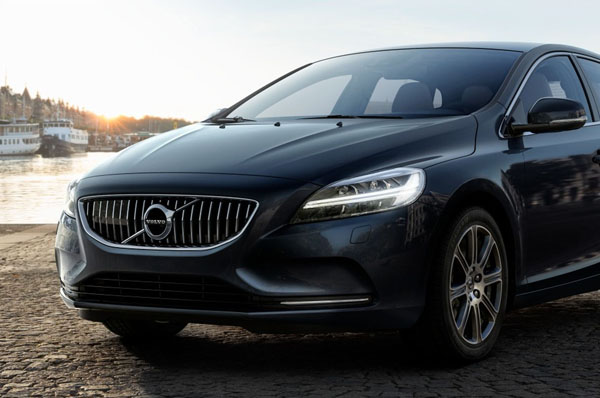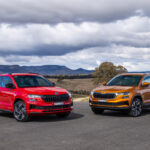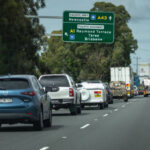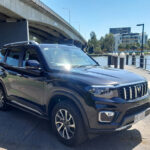
The V40 is the smallest vehicle in Volvo’s Australian range. A five-door hatchback it competes in the premium small-medium category facing up against prestige German models such as Audi A3, BMW 1 Series and Mercedes-Benz A- and B-Class.
Although the current V4 has been around in its current guise since 2013 it is one of the most stylish cars on the road as well as being one of the most intelligent and safest. The latter no surprise given the Swedish company’s long-established emphasis on safety.
STYLING
The sleek, almost coupe-like, roofline doesn’t make it easy to get in and out of the V40 and taller drivers may need to set the seat height to its lower limit. Legroom in the rear is adequate and shoulder space not overly cramped for three people of average build.
The current (MY2017) V40 Australian range was released in September 2016 with a minor facelift. The undoubted highlight is new headlights that feature daytime running lights that run across the centre and because of their shape have been given the delightfully Scandinavian name of the ‘Hammer of Thor’. The headlight beams swivel into corners.
The only other changes are a new grille mesh design and the latest Volvo ‘Iron Mark’ logo in the centre of the grille.
Ergonomic design and simplicity abound inside the Volvo V40’s cabin. There are quality materials throughout. Below the armrest is a storage compartment suitable for small items, while the glove compartment includes space for two cans or bottles. The latter are cooled by air from the climate control system.
There’s plenty of choice in the 2017 Volvo V40 range with a total of six variants including petrol and diesel engines; front- and all-wheel drive and three specification levels.
Prices range from $36,500 for the front-wheel-drive T3 Momentum through to $50,990 for the Cross Country (all-wheel drive R-Design).
ENGINES / TRANSMISSIONS
There are five different power and torque outputs across the six models, two petrol and three diesel. All are turbocharged and with torque levels between 250 Nm and 400 Nm depending on the model.
The V40 D2 gets a 1.5-litre diesel with outputs of 88 kW and 280 Nm. All others have 2.0-litre engines with different levels of tune. The lower-specced of the petrol engines in the T3 has more power (112 kW) but less torque (250 Nm); the D4 diesel has 140 kW of power and, with 400 Nm (from 1750 rpm), has the most torque of any model. The T4 sits mid-range with 140 kW and 300 Nm.
The most powerful engine, used in the T5 R-Design and Cross Country models, peaks at 180 kW with torque of 350 Nm.
The D2, T3 and T4 have six-speed adaptive automatic transmission, the D4 and T5 get eight-speed autos. All models have Sport mode, paddle shifters and emission-reducing stop/start technology.
INFOTAINMENT
The Volvo Sensus infotainment system uses either a 5.0 or 7.0-inch colour screen, depending on the model, in the upper instrument panel. All functions can be operated from the steering wheel or via controls located directly below the screen.
With the optional multimedia audio system, Volvo Sensus steps up to a 7.0-inch screen that also displays information and images from the navigation system, phone, reversing camera, DVD player and more.
A new digital instrument cluster directly in front of the driver uses a TFT (Thin Film Transistor) crystal display to present the most important information in any situation.
The driver can choose between three graphic themes: Elegance, a traditional amber illumination; Eco, a green background illumination, designed to create an environmentally-inspired look; and Performance, with a sporting red lighting.
Vehicle speed is shown digitally in the centre of the display. The right display includes a power meter – a gauge that informs the driver how much power is available and how much power is being used at any time.
SAFETY
Standard across the V40 range are seven airbags; ABS brakes with emergency braking, hydraulic brake assist and electronic brake distribution; advanced stability control with corner traction control; roll-over protection; front seat whiplash protection.
Additional safety features include lane departure warning; lane keeping aid; forward collision warning; active high beam control; adaptive cruise control; blind spot warning; and cross traffic alert.
A couple of stand-out features are Volvo City Safety and Pedestrian Airbag Technology. The former, which was pioneered by Volvo, is now being taken up by many other car makers. Using sensors and cameras the car ‘looks’ down for pedestrians and other risks and if need be applies full auto braking. It can avoid, or at least minimise, collisions at speeds up to 50 km/h.
Pedestrian Airbag Technology is another breakthrough safety development. Seven sensors in the front of the car transmit signals to a control unit. When the car hits an object, the signals change, and if the car ‘thinks’ the object is a human leg the pedestrian protection system reacts. The bonnet rear hinges are released and the bonnet lifts to get it away from the hard surfaces under it. The pedestrian airbag is activated. The airbag covers the entire windscreen-wiper recess, about a third of the windscreen and the lower part of the A-pillars.
Other safety features include reversing camera; front and rear parking sensors; park assist pilot. Convenience items include height and reach adjustable steering wheel; adjustable speed limiter; and hill start assist.
DRIVING
Our test car was the diesel-powered D4 Inscription with the optional Polestar Performance Parts pack. For around $10,000 it adds both extra performance and sportier styling. Included in the pack are engine software optimisation that increases power from 140 to 147 kW and torque from 400 to 440 Nm; stainless steel exhaust; rear diffuser; sports air filter; coil springs; 19-inch lightweight rims; rear spoiler; black door mirrors; and sports pedals.
The low driving position, large C-pillar and small rear window combine to make reversing awkward – we feel the reversing camera and all-round sensors are a must in the V40.
The Volvo has smooth acceleration thanks not only to the design of the engine, but also because of impressively fast gear shifts.
The stiffer suspension worked well on bitumen surfaces, although the ride was a tad harsh on some of our local rural roads.
Steering is direct and produces positive feedback of the type that’s enjoyed by enthusiastic drivers. Electrical power assistance can be optioned in three ways: City, with a high degree of power support for easy manoeuvring; Normal offers more road response at higher speeds; and Sport, adds a dynamic character.
Fuel consumption is listed at 4.5 litres per 100 kilometres in the standard D4. The combination of some occasional vigorous and the inclusion of the Polestar pack saw us averaging 7.8 L/100 km during our week-long test.
SUMMING UP
Around 80 per cent of all sales in the Australian small premium new car segment are shared between the big three German brands. Volvo gets a meagre 8 per cent with the V40 which is surprising because, in our view, it’s the most attractive car in the field, is packed with safety equipment and is great fund to drive. We’d highly recommend taking one for a test drive before making a final decision.
AT A GLANCE
MODEL RANGE
D2 Momentum 2.0-litre turbo-diesel five-door hatch: $37,800 (automatic)
T3 Momentum 1.5-litre turbo-petrol five-door hatch: $36,500 (automatic)
D4 Inscription 2.0-litre turbo-diesel five-door hatch: $44,990 (automatic)
T4 Inscription 2.0-litre turbo-petrol five-door hatch: $43,500 (automatic)
T5 R-Design 2.0-litre turbo-petrol five-door hatch: $48,990 (automatic)
T5 Cross Country Inscription 2.0-litre turbo-petrol five-door hatch: $50,990 (automatic)
Note: These prices do not include government or dealer delivery charges. Contact your local Volvo dealer for drive-away prices.
SPECIFICATIONS (Volvo V40 D4 Inscription 2.0-litre turbo-diesel five-door wagon)
ENGINE:
Capacity: 1.968 litres
Configuration: Four cylinders in line
Maximum Power: 140 kW @ 4250 rpm
Maximum Torque: 400 Nm @ 1750 rpm
Fuel Type: Diesel
Combined Fuel Cycle (ADR 81/02): 4.5 L/100km
CO2 Emissions: 118 g/km
DRIVELINE:
Eight-speed automatic
DIMENSIONS, WEIGHT AND CAPACITIES:
Length: 4370 mm
Wheelbase: 2647 mm
Width: 1857 mm
Height: 1458 mm
Turning Circle: 11.3 metres
Kerb Mass: 1512 kg
Fuel Tank Capacity: 60 litres
BRAKES:
Front: Ventilated disc
Rear: Solid disc
STANDARD WARRANTY:
Three years / unlimited km












